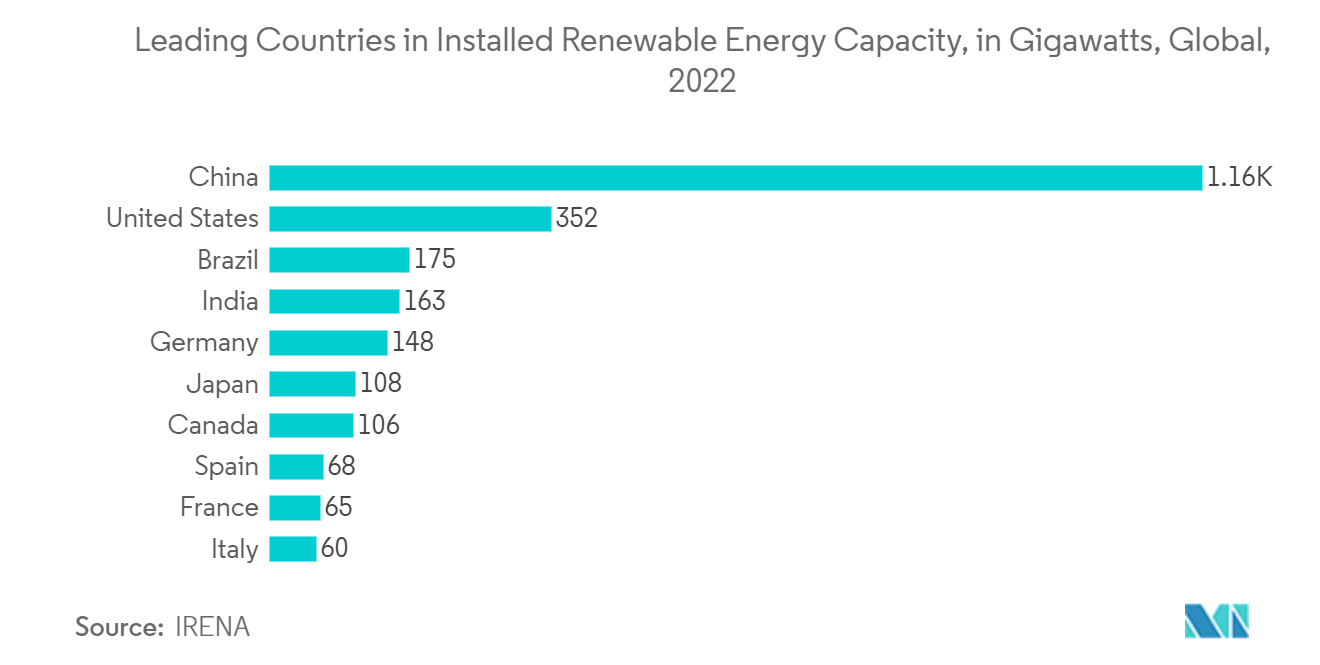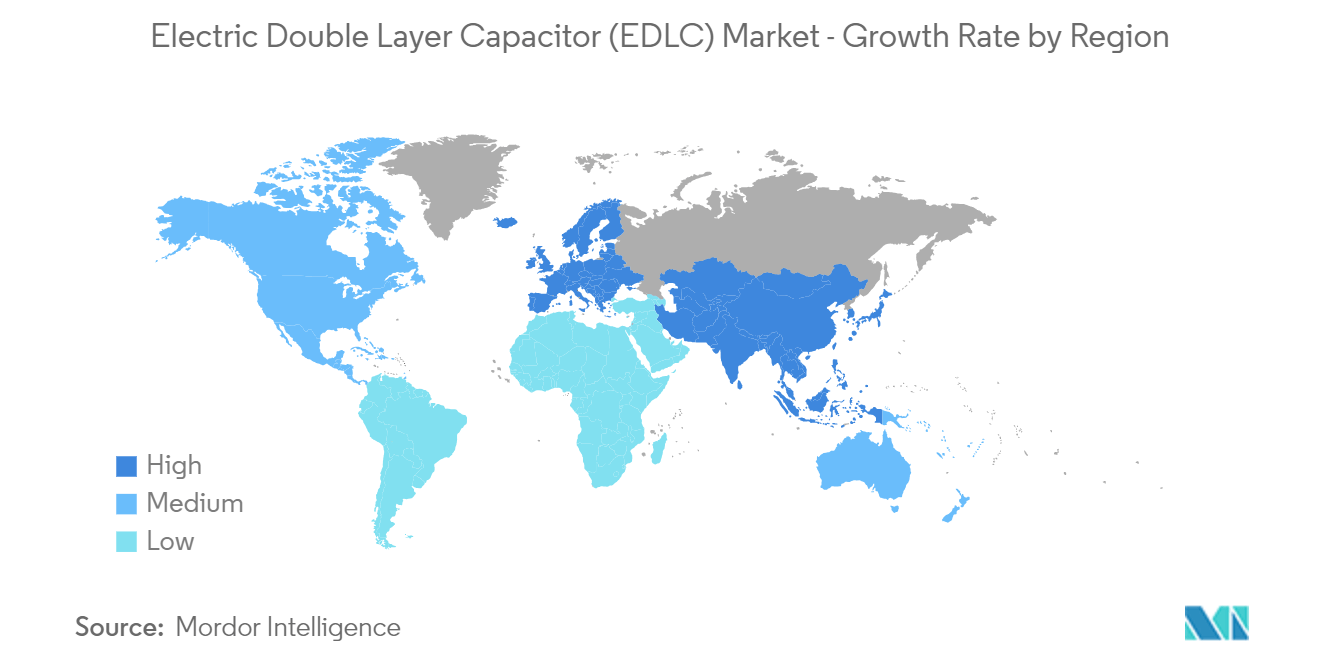Market Trends of Electric Double-layer Capacitor (EDLC) Industry
Rising Demand for Renewable Energy Solutions Drives the Market's Growth
- The use of EDLCs for renewable energy applications has grown over the years. Hence, increasing the focus on renewable energy sources is a huge opportunity for EDLC manufacturers. Currently, Asia-Pacific is growing significantly in renewable energy consumption, its variants, and other potential materials, which is driving the EDLC market growth. EDLC is a new energy storage device that can provide more power density than batteries and more energy density than ordinary capacitors.
- Due to their advantages, such as very high efficiency, high charge/current discharge capability, and wide temperature range, EDLCs are being employed in an expanding variety of applications, including renewable energy power production, transportation, power systems, and many more. A hybrid energy storage system consisting of a battery and EDLC (SC) is proposed for use in wind farms to achieve power dispatch ability. The designed scheme controls the battery's charging/discharging powers while the faster wind power transients are diverted to the EDLC. This prolongs the battery's life.
- Several government initiatives will likely drive EDLCs in the market. For instance, the Chinese authorities have recently announced a plan to add more than 30 gigawatts of energy storage capacity by 2025 to enhance renewable energy usage while stabilizing the electric grid. Electricity storage techniques that use electrochemical, compressed air, flywheel, and EDLC systems are referred to as new energy storage, as opposed to pumped hydro, which uses water held behind dams to create electricity as needed.
- According to International Renewable Energy Agency (IENA), in 2022, China was the leading country in terms of installed renewable energy capacity (1,161 gigawatts(GW), followed by the United States (352 GW), Brazil (175 GW), and India (163 GW). With these numbers anticipated to grow further, the renewable energy sector is anticipated to continue to drive the demand for EDLCs.
- Furthermore, energy storage is one of the biggest obstacles preventing the widespread use of renewable energy sources, like wind and solar power. The US energy grid system is used for distributing energy and allows for limited flexibility for the storage of excess on short notice. Conventional EDLCs have a high-power output with minimal performance degradation for as many as 1,000,000 charge-discharge cycles.
- There are upgrades to power generation from renewable resources to reduce the rapid depletion of natural resources, which is expected to drive the market for EDLCs in the coming years. There is an increasing demand for renewable energy generation, observed in countries across Europe, Asia, and the United States, which would further fuel the growth of the market studied.

Europe to Hold Significant Market Share
- The growing adoption of EDLCs in the automotive industries has positively boosted the market's growth in the region, as Europe is among the fastest-growing EV markets. The German automotive industry has been leading technological innovations in the global automotive industry with the integration of smart technologies. Hybrid and electric vehicles are expected to lead the growth of the automotive industry in the country, with the companies focusing on electric vehicle technologies. This is anticipated to impact the growth of the EDLCs market positively.
- The European Commission's Graphene Flagship initiative aims to take graphene from the lab to society within a decade. The initiative's issues in the energy field include the production of graphene to address the requirement of high-quality materials in large quantities, its integration into energy devices while preserving its properties, and device performance improvements using scalable methods suitable for commercialization. As graphene-based materials are widely used as electrodes of EDLCs, such trends favor the studied market's growth.
- Furthermore, European automotive players, such as Lamborghini, the Italian manufacturer of luxury sports cars, have worked in the past with research institutes such as Massachusetts Institute of Technology to build the Lamborghini Terzo Millennio. This electric vehicle uses EDLCs embedded into the car's chassis as a source of energy. Lamborghini's first series-production hybrid cars included advanced electric technology, with the supercar manufacturer focused on lightweight EDLCs and the capacity to store electrical energy in carbon fiber bodywork. The success of such efforts are anticipated to drive more auto manufacturers adopt similar strategy which in turn will drive opportunities in the studied market.
- Due to the rapid investments and government initiatives in several EU regions, there is likely to be a market for EDLC as a result of the surge in renewable energy investments across Europe. The EU Parliament agreed on additional measures in December 2022 to increase the percentage of renewables in the EU considerably ahead of 2030 in response to Russia's aggressiveness in Ukraine and to address the EU's reliance on Russian fossil fuels.
- As a result, the market is expected to continue to profit from the growing use of renewable wind energy in Europe over the forecast period as supercapacitors gain prominence in big wind turbine pitch control applications. For instance, in order to achieve its 2030 climate and energy goals, the EU is predicted to deploy 116 GW of new wind farms between 2022 and 2026, according to Windflix Europe. Using the enormous potential of the five EU sea basins, the installed offshore wind capacity in the EU, which was 14.6 GW in 2021, is expected to expand by at least 25 times by 2030.


